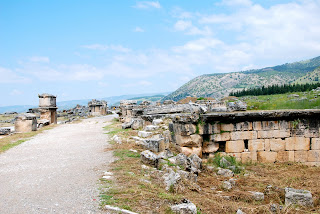Pamukkale and Hieropolis
The ancient city of Hieropolis and the natural mineral formations of Pamukkale, ‘cotton castle,’ are in the Denizli Province, about 3 hours from our hotel in Kusadasi. Created by hot springs that continue to fill warm pools on its surface, Pamukkale is a popular attraction for Russian and Polish tourists who believe its waters have healing and fortifying properties. They are not the first to believe this; it has been used as a spa since the 2nd century BC.
Hieropolis, an ancient city built next to the top of Pamukkale, was a Greek spa town turned into Roman city of a 100,000. Thousands of people visited for the medicinal properties of its hots springs; although, as the tour book I had wittily pointed out, the extensive walkway through sarcophagi makes one wonder how effective these waters were.


I wish these pictures could better show how huge Hieropolis was. The path through the ruins was several kilometers with very few people on them. Most of the tourists seemed more interested in soaking in the pools on Pamukkale and adding to their sunburns.


I wish these pictures could better show how huge Hieropolis was. The path through the ruins was several kilometers with very few people on them. Most of the tourists seemed more interested in soaking in the pools on Pamukkale and adding to their sunburns.
Ephesus
Ephesus an ancient city during the Greek and Roman Empires had a population of 250, 000 people in the 1st century BC making it the world’s second biggest city at the time. The area around Ephesus was inhabited as early as 6000BC, but didn’t become a proper city until the Bronze Age.
After being attacked by the Goths in 263 AD, the city began declining though it wasn’t fully abandoned until the 15th century. Once a port city on the Aegean Sea, Ephesus now lies 5 kilometers from the coast. The river Küçük Menderes deposited tons of silt in the harbor each year. Despite efforts to dredge the harbor, even as far back as Roman times, the coast continued to retreat from Ephesus. Decline was further hastened by an earthquake in 614 and further attacks by Arabs in 654-655, 700, and 716 AD.
 |
| Unlike Pamukkale, there were tons of tourists at Ephesus. |
Ephesus played a big role in the early development of Christianity. The Apostle Paul lived there in the 50s and a house nearby is believed to have been where Mary lived until her death. It also the site of the story of the Seven Sleepers, considered saints in the Catholic and Orthodox traditions. The Seven Sleepers, a story also found in the Quran, describes a group of Christian youths who hid in an Ephesian cave to escape Roman persecution around 250 AD. While praying in the cave, they fell asleep, awaking 150-200 years later and finding Ephesus a Christian city. In the Quranic version, a dog accompanied them to the cave and kept watch while the slept.
House of the Virgin Mary
House of the Virgin Mary, 4 kilometers from the Ephesus ruins, is where people believe Jesus’ mother came to live with John. The Third Ecumenical Council and Second Council of Ephesus were held there in 431 and 449. Today, people write wishes on cloth or napkins and tie them to a prayer wall, light candles, and drink water from the three natural springs which are supposed to help with health, wealth, etc.
Peace and Friendship Square, Kusadasi








No comments:
Post a Comment